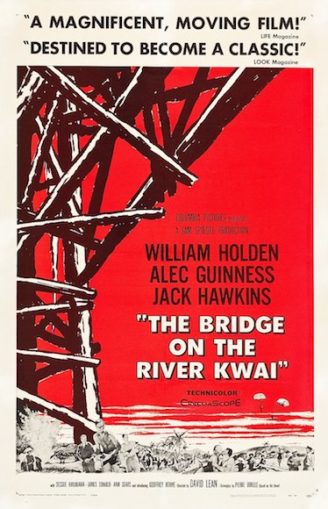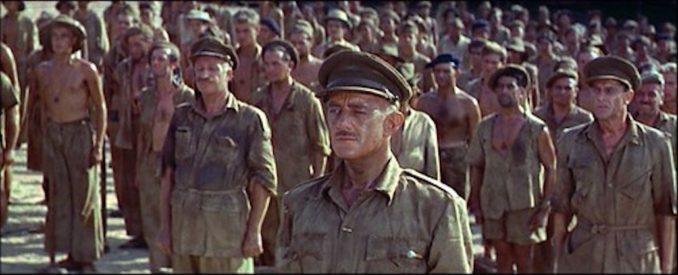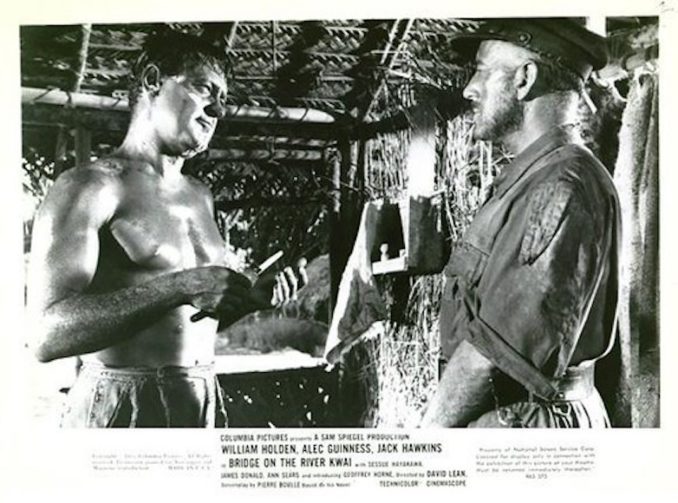
“Style A” poster for the US theatrical release of the 1957 film The Bridge on the River Kwai,
Columbia Pictures Corporation – Public domain
David Lean’s The Bridge on the River Kwai (1957) is not just a great film, it is a nearly perfect one. Even better, it was recognised as such from the start by virtually everyone. The critics lionised it and continue to include it on their “best” lists. The movie business showered it with prizes. Bridge won seven Oscars, including best picture and best director. Audiences made it the biggest film of 1957 and a perennial favourite ever since. Bridge was Lean’s twelfth film and his first “epic,” which cast the die for the rest of his career. It was followed by Lawrence of Arabia (1962) and Doctor Zhivago (1965), also classics. Then Lean ended his career with Ryan’s Daughter (1970) and A Passage to India (1984), which fail as films – relatively speaking – in part because their stories were overwhelmed by Lean’s epic style of treatment, which by then had hardened into mannerisms.
Bridge might have shared the same fate because of its source material. Lean’s film adapts Pierre Boulle’s best-selling 1952 novel Le Pont de la Rivière Kwaï. (Boulle is also famous for another novel that made it to the screen as Planet of the Apes.) The novel is set in Japanese-occupied Thailand during the Second World War. The Japanese are building a railroad to connect Bangkok with Rangoon using forced labour, both native civilians and British prisoners of war.

Sir Alec Guinnes as Colonel Nicholson, received the Oscar the next year,
Susan Lennox – Public domain
The British prisoners in a particular camp are tasked with building a bridge over the River Kwai. The main conflict is between the Japanese camp Commander Saito and British Lt. Colonel Nicholson. Saito demands that officers do manual labour. This being contrary to the military code, Nicholson refuses, and he and his officers are punished. Naturally, the construction project is plagued by sabotage. Saito eventually relents because he needs the cooperation of the British officers to finish the bridge on schedule. Nicholson then marshals his men in order to build a better bridge than the Japanese could have done. Nicholson appeals to legalism, esprit de corps, and British chauvinism — but they all fall short of a case for enthusiastic collaborationism. The core of the novel is the absurdity of a man who collaborates with the enemy out of a misplaced sense of duty. It is not clear if Nicholson is supposed to be an imbecile or a madman, but he’s definitely something of a buffoon: a snob, a bore, a martinet, and ultimately a traitor.
Most Brits who read the novel found it to be offensive and rather tasteless: offensive, because it reads as a rather crude Gallic lampoon of the British national character, especially the British military; tasteless, because approximately 13,000 prisoners of war died during the construction of the railway, plus up to 100,000 of the local civilians; it is just not something to be treated lightly.
Lean followed Boulle’s plot fairly faithfully. The main departure, (spoiler) the destruction of the bridge at the end of the film, was approved by Boulle. Where Lean departed from Boulle, is in his treatment of the character of Nicholson. Lean turned Nicholson from a buffoon into a tragic hero worthy of Sophocles or Shakespeare. In Lean’s eyes, Nicholson stands for genuine virtues: patriotism, loyalty, duty, pride in one’s work, and obedience to law, authority, and moral principles. He wouldn’t be a tragic hero unless he had genuine virtues. Nicholson’s “tragic flaw” is that he does not see that his virtues only really make sense when practiced among his own people, for their benefit. In the prison camp, however, these virtues are being exploited by a ruthless enemy who aims to destroy the Empire that Nicholson so loyally fought to preserve. There’s perhaps a lesson in this for the UK today, since our openness to strangers, altruism, and moral idealism are being exploited by a system that is destroying us as well.
The Bridge on the River Kwai is masterful at exploring the fundamental distinction between aristocratic ethos that prizes honour above all else and the bourgeois ethos that prizes comfort, security, long life, and pleasure above all else. G. W. F. Hegel famously claims that history begins with a battle to the death over honour, in which two men are willing to risk their lives for an idea. Prehistory is governed by the necessities of life. History is governed by ideas. If both men prize honour above life, and one is defeated, he will choose death before dishonour. But if the defeated party chooses life at the price of honour, he is revealed to be a very different kind of man who is reduced to the status of a slave, to toil for the victor. This is exactly how Japanese Commander Saito (played by Sessue Hayakawa) sees the matter. By surrendering, the British have lost their honour and have been reduced to slaves, including the officers, thus all must work. Saito will not spare the officers from the full measure of their disgrace because of a mere legalism that forbids imprisoned officers from doing manual labour, as if they were still gentlemen. To him, the Geneva Convention is as nothing when compared to the Japanese warrior code of bushido. The Japanese military felt superior to the British because the Japanese still committed suicide to avoid the dishonour of defeat, whereas the British, being a Christian nation, rejected suicide and used legalisms to preserve their honour even in defeat.
The dispute between Saito and Nicholson — brilliantly portrayed by Alec Guinness — becomes another struggle to the death over honour. Saito puts Nicholson in a metal box in the blazing sun to break his will, but he refuses to relent and do manual labour, even if it kills him. Unfortunately for Saito, the bridge is behind schedule, the Japanese engineer is incompetent, and the prisoners are at best sullen workers, at worst prone to malingering and sabotage.
If the bridge is not committed on schedule, Saito will be expected to commit suicide, a fate that he wishes to avoid. Thus Saito uses the anniversary of the Japanese victory over Russia as the occasion for a face-saving amnesty. Nicholson and his officers will not have to labour but will organize their men to complete the bridge on time. The roles have been reversed. Nicholson has chosen death over dishonour, and Saito has flinched, choosing dishonour over death. It is Nicholson’s high point. After that, his fall begins. Nicholson’s quest to build a better bridge than the Japanese also makes sense in terms of Hegel’s master-slave dialectic. Nicholson has beaten Saito on an essential point of honour. But he is still a prisoner, and his men are still slaves. However, Hegel describes a pathway by which the slave can restore his self-respect and humanity. The master rules over men, including slaves. The slave, however, can make himself a master over nature, which is what Nicholson and his men do by building the bridge, and doing it better than the Japanese could. Saito is shamed by this, and even though the bridge is completed on time, he still plans to kill himself.
But in a deeper sense, the Japanese have still won, because they got their bridge, which is an important strategic asset in their war against the British. Next stop: India!
Since both Saito and Nicholson are master types, albeit at times “temporarily embarrassed” master types, the film needs a well-developed slave type as a contrast. The American studio wanted a big American star to appeal to American ticket buyers. Enter William Holden as the American Commander Shears. (In the novel, Shears is British.) The Americans also wanted a love interest to appeal to chicks. Lean groaned, because war stories are guy stories. (Lean got his way on his next film, Lawrence of Arabia, in which there are no speaking roles for women.)
A slight digression here. A family friend, as part of his National Service, was sent out to Malaya in 1956 during the Insurgency. Their troopship called in at Columbo to effect engine repairs, a welcome three-week break & unexpected paid leave. He, as an officer, ended up in the best billet, in a farmhouse up in the hills, within walking distance of the Government Rest House in Kitulgala, where the cast & crew involved in the making of BoTRK were staying. He even snagged himself a (very) minor part in the scene where Shears/Holden meets Warden/Hawkins & gets blackmailed into returning to the jungle. He’s always said that both Holden & Hawkins were excellent company & monumental drinkers off-set, but that Holden was in a league of his own as a babe magnet.

William Holden & Alec Guinness,
Susan Lenox – Licence CC BY-SA 2.0
Lean gave in to the studio but turned defeat into victory, because the character of Commander Shears is a brilliant encapsulation of the slave type: cowardly, dishonest, and cynical about honour. Shears’ character is brought into sharper focus by making him an American, since America is a thoroughly bourgeois society that took pride in throwing off European aristocratic civilization, although vestiges of its ethos survived among the military and Southern planters. Making Shears a womaniser to boot perfected the character. But don’t fear: Shears has a redemption arc and chooses death over dishonour in the end. There is still hope for the Yanks. By making an American the voice of cynicism, cowardice, and dishonesty, Lean also perfects another trait of the film. Inverting Boulle’s Gallic snark, Lean’s Bridge is a pean to the British character and especially the British military. Lean’s politics are complicated. He was conservative, patriotic, and despised communism. He was a tax exile for years because he also despised the British Labour Party. But Lean was also drawn to such anti-colonial, anti-imperialistic figures as T. E. Lawrence and Gandhi. (Lean wanted to do a movie about Gandhi and actually met Nehru to discuss the project.) Yet in films like Bridge and Lawrence of Arabia, Lean presents the British Empire in a highly flattering light.
Like every Lean film, The Bridge on the River Kwai is a first-class production. The cast is excellent, with particularly distinguished performances by Alec Guinness (who won the Oscar for best actor), William Holden, and Jack Hawkins. The musical score by Malcolm Arnold is one of his best and was duly rewarded with an Oscar. The striking locations in Ceylon were captured by cinematographer Jack Hildyard, who also received an Oscar, as did editor Peter Taylor. The script of Bridge, which also won the Oscar for best adaptation, is a masterpiece. Originally, the script was credited to Boulle, who didn’t even speak English. Boulle’s name was there in place of two blacklisted writers, Carl Foreman and Michael Wilson. But everything that makes the script deep and powerful is the work of David Lean.
I have talked about the central themes of Bridge, but I have left out a great deal of the story, because I want you to enjoy discovering it for yourself. But I should warn you that, although The Bridge on the River Kwai is a beautiful and entertaining spectacle, it is also deeply tragic. This makes the film’s popularity all the more remarkable. It is proof that even “the masses” are not satisfied by mere entertainment. They hunger for deep feelings, even painful ones, if they are stirred by an encounter with deep truths about the human condition.
Original trailer of the film The Bridge On The River Kwai (1957):
© DJM 2022



